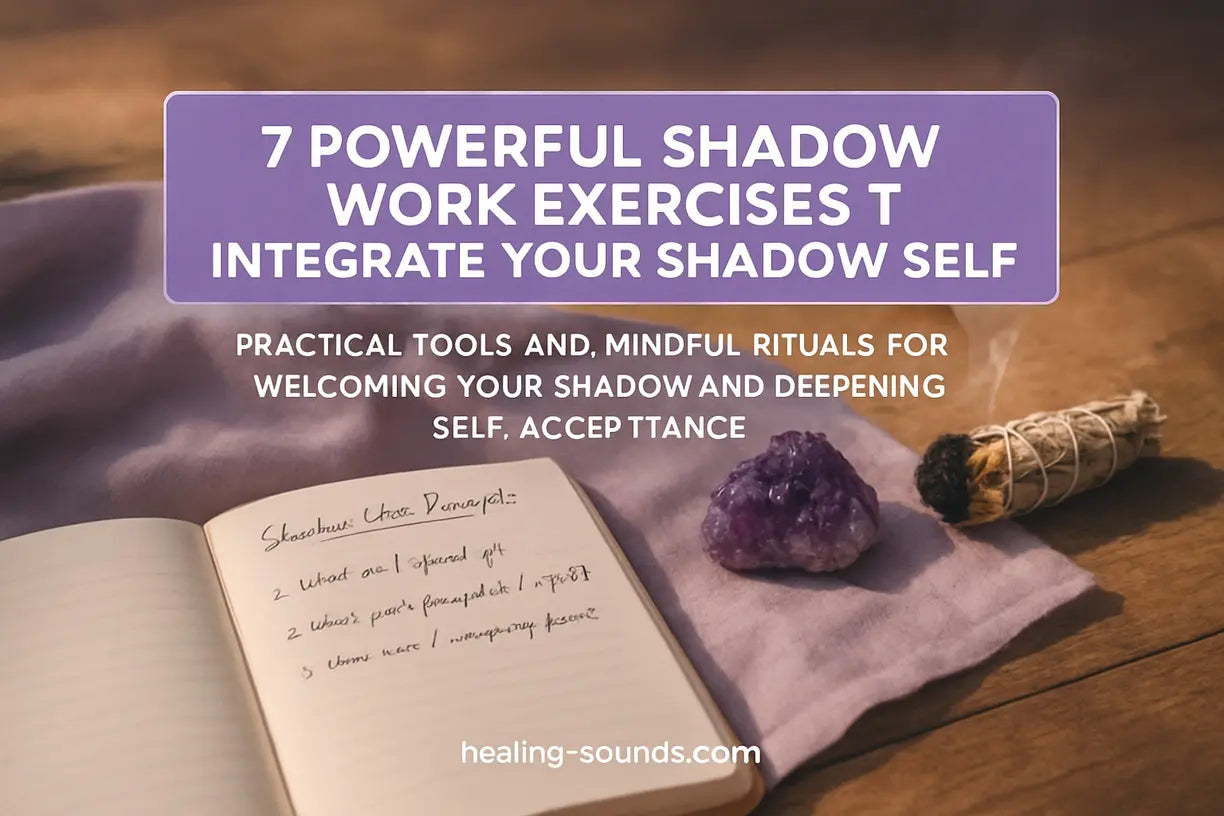Embarking on a journey of self-discovery often leads us down paths we never expected, deep into the terrain of our own minds. If you're here, you've likely heard whispers of the "shadow self"—that hidden part of your consciousness—and you're curious about how to connect with it. The process of integrating these hidden aspects is known as shadow work, and it's one of the most transformative practices for personal growth. This guide is designed to provide you with powerful and practical shadow work exercises to help you begin this journey toward wholeness and authenticity.
Many of us spend our lives avoiding the parts of ourselves we deem unacceptable, but true healing comes from turning toward them with compassion. You're not looking to eliminate your shadow; you're looking to understand it, learn from it, and integrate its wisdom. By doing so, you can unlock profound creativity, build unshakeable confidence, and foster deeper connections with others. Let's explore how you can start today.
What is Shadow Work? (And Why It's Worth It)
First introduced by Swiss psychiatrist Carl Jung, the "shadow" refers to the parts of our unconscious mind where we store everything we can't or won't see about ourselves. This includes repressed feelings, weaknesses, desires, and instincts that our conscious mind rejects. Because society and our upbringing often label these traits as "bad" or "unacceptable," we push them into the darkness.
Shadow work is the courageous process of exploring this inner darkness. The goal isn't to judge or fix these hidden parts but to bring them into the light of awareness. When we ignore our shadow, it tends to control us from behind the scenes, often showing up as emotional triggers, self-sabotage, or unhealthy projections onto others. By engaging in shadow work exercises, you can reclaim these fragmented pieces of yourself, leading to greater self-awareness, emotional freedom, and a more authentic, integrated life.
Preparing for Your Shadow Work Practice
Before you begin, it's essential to create a safe and supportive environment. Shadow work can bring up intense emotions, so self-compassion is non-negotiable. Find a quiet, private space where you won't be interrupted. You might want to light a candle, burn some cleansing sage, or play soft, calming music.
Gathering a few simple tools can also enhance your practice. A dedicated shadow work journal is your most powerful ally, allowing you to record your thoughts and discoveries without judgment. Many people also find that crystals, like amethyst, help create a calm and focused atmosphere for introspection. The key is to make your practice feel like a sacred ritual of self-care.

7 Powerful Shadow Work Exercises for Beginners
Ready to begin? Here are seven effective shadow work exercises designed for those new to the practice. Start with the one that resonates most, and remember to be patient and gentle with yourself throughout the process.
-
Journaling with Shadow Prompts
Journaling is the cornerstone of shadow work. It provides a direct line to your unconscious thoughts and feelings. Instead of free-writing, use targeted shadow work prompts to guide your exploration. These questions are designed to challenge your perceptions and uncover hidden beliefs.
Sample Prompts to Get You Started:- What qualities in others irritate me the most?
- What was I taught to believe about anger/sadness/fear as a child?
- What secrets do I keep, even from myself?
- Describe a time I felt intense jealousy. What did I believe that person had that I lacked?
As you write, let your thoughts flow without censorship. Don't worry about grammar or making sense. The goal is raw, honest expression. Holding a calming crystal like amethyst can help you stay centered and open as you delve into these deeper questions.


Amethyst Crystal Tower for Meditation and Harmony
$59.99 $79.99
Deepen your shadow work practice by focusing your intention and clarity with this soothing amethyst crystal tower.
Explore Product -
The '3-2-1' Process
This powerful exercise helps you reclaim projections—the traits you see in others that are actually unowned parts of yourself. It's a structured way to integrate your shadow self. Find something or someone that is currently triggering you emotionally (either positively or negatively) and follow these steps:
- Face It (3rd Person): Describe the person or situation from an objective, third-person perspective. Write down exactly what you see and the traits that stand out to you.
- Talk to It (2nd Person): Imagine having a dialogue with this person or object. Ask it questions: "Why are you here?" "What do you have to tell me?" Write down the conversation from your perspective.
- Be It (1st Person): This is the crucial step. Embody the traits you described. Speak from that perspective using "I" statements. For example, if you described someone as "arrogant," you would write, "I am arrogant. I am..." This step allows you to feel and ultimately own the disowned part of yourself.
-
Active Imagination & Visualization
This Jungian technique involves creating a dialogue with figures from your dreams or imagination that represent parts of your shadow. Find a quiet space, close your eyes, and allow an image to surface—it could be a person, an animal, or a mythical creature. Ask it what it wants and listen to its response without judgment. This shadow work exercise can reveal profound insights about your inner needs and fears.
-
The Mirror Technique
The people who trigger us the most are often our greatest teachers because they mirror back the parts of our shadow we need to see. The next time you have a strong negative reaction to someone, pause and ask yourself: "What specific trait in this person is bothering me?" Then, ask with radical honesty: "Where in my own life do I exhibit this same trait, even in a small way?" This isn't about blaming yourself, but about using your reactions as a compass pointing toward your own unexamined behavior.
-
Body Scan Meditation
Our bodies hold emotions and memories that our conscious minds have forgotten. A body scan meditation can help you connect with the physical sensations of your shadow. Lie down comfortably and bring your awareness to your body, starting with your toes and moving slowly up to your head. Notice any areas of tension, numbness, or discomfort. Instead of trying to fix them, simply breathe into these sensations with curiosity. Ask the area what it's holding. This practice helps you understand how your shadow manifests physically.
-
Letter to Your Shadow Self
Write a compassionate letter to your shadow. Acknowledge its existence and thank it for the ways it has tried to protect you, even if its methods were misguided. Apologize for ignoring or rejecting it for so long. Ask it what it needs from you to feel seen and heard. This exercise can be incredibly healing, as it shifts your relationship with your shadow from one of conflict to one of collaboration and deep self-compassion.
-
Tracking Your Emotional Triggers
An emotional trigger is an intense, often disproportionate, reaction to a situation. These triggers are direct signposts to your shadow material. For one week, keep a small notebook or use a notes app to log every time you feel triggered. For each instance, write down:
- What was the situation?
- What was the emotion I felt (e.g., anger, shame, envy)?
- What was the underlying belief or fear that got activated?

Enhance Your Practice with These Tools
Carry your shadow work journal and crystals in style with this symbolic, artisan-crafted mindful backpack for daily integration. Learn more ➔
Integrating Your Shadow Self into Daily Life
Shadow work is not a one-time fix; it's an ongoing practice of self-awareness and integration. As you continue these exercises, you'll become more adept at recognizing your shadow in real-time. The goal is to move from formal exercises to a continuous state of mindful self-reflection. When you feel triggered, you'll learn to pause and look inward rather than react outward. As noted in psychological resources like those from the American Psychological Association, understanding our cognitive biases and projections is key to mental well-being.
Carry the lessons from your practice into your daily life. Be kinder to yourself when you make a mistake. Acknowledge your "negative" emotions without letting them control you. This continuous integration is where the true magic of shadow work happens, leading to a life of greater authenticity, peace, and wholeness.
Your Journey to Wholeness Starts Now
Engaging in shadow work exercises is a profound act of self-love. It's an acknowledgment that you are a complex, multi-faceted being, and every single part of you deserves to be seen and understood. By bravely exploring your inner world, you reclaim your power and step into a more authentic version of yourself.
Choose one exercise from this guide to begin with. Be patient, be compassionate, and trust the process. Your journey into the shadow is a journey back to the wholeness that has been waiting for you all along.
Frequently Asked Questions about Shadow Work Exercises
You can practice shadow work through various methods, but the core practice involves self-reflection to uncover and understand your unconscious aspects. Common techniques include journaling with specific prompts, meditation, active imagination, analyzing emotional triggers, and working with a therapist. The key is to create a safe space to explore uncomfortable feelings and hidden beliefs with curiosity and compassion rather than judgment.
A classic example is the "mirror technique." If you find yourself intensely irritated by a coworker you perceive as "lazy," shadow work invites you to look in the mirror. You would ask yourself, "Where am I 'lazy' in my own life?" Perhaps you procrastinate on personal projects or avoid difficult emotional conversations. By identifying that same trait in yourself, you acknowledge your own disowned "laziness," reducing the emotional charge you feel toward your coworker and integrating that part of your shadow.
The 3-2-1 process is a specific exercise to integrate projections. It involves three steps: 1. Face It (3rd Person): Describe a person or situation that triggers you objectively. 2. Talk to It (2nd Person): Engage in an imaginary dialogue with this trigger, asking it questions. 3. Be It (1st Person): Embody the qualities of the trigger and speak from its perspective using "I" statements. This process helps you own the disowned trait and reclaim the energy you were projecting outward.
Good shadow work prompts are open-ended questions that challenge your conscious beliefs and invite you to explore uncomfortable feelings. Examples include: "What traits in others do I secretly admire but feel I can't express?", "What am I most afraid of people discovering about me?", "What family secrets was I taught to keep?", and "How did my parents handle anger, and how does that affect me today?".
Great beginner exercises include: 1. Journaling: Start by answering simple prompts about your emotional triggers. 2. Tracking Triggers: Keep a log of what upsets you during the day to find patterns. 3. Writing a Letter: Write a compassionate letter to a part of yourself you dislike. These exercises are gentle yet effective ways to start building awareness of your shadow self.













